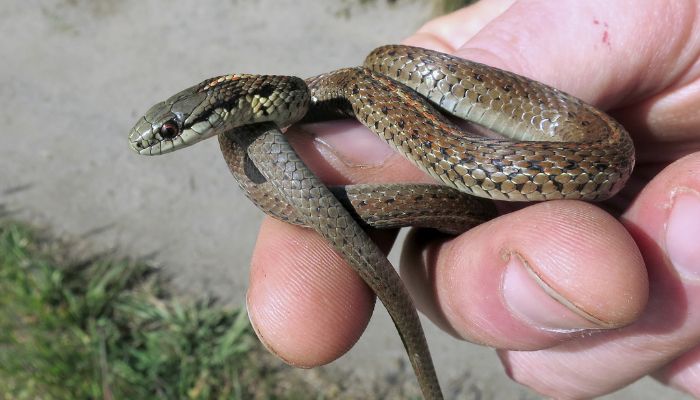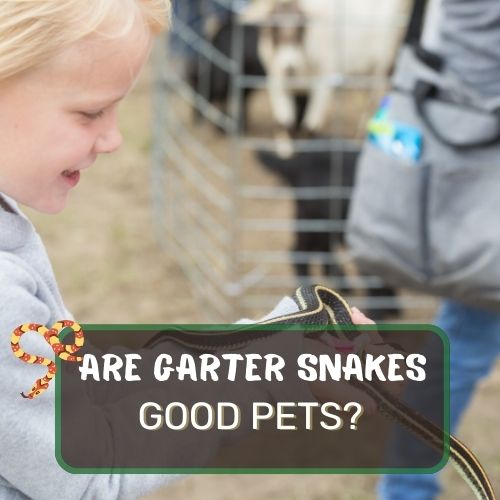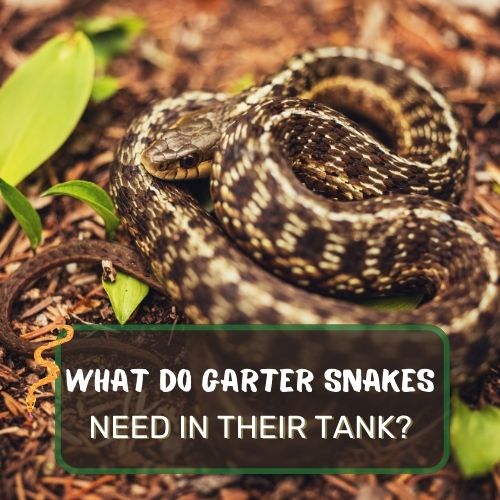Snakes, with their mysterious allure, have always fascinated us. But have you ever wondered about their social dynamics, especially when it comes to living together?
In the wild, they often form groups, especially during hibernation. In captivity, several can coexist in a spacious enclosure, provided they have ample resources. However, the exact number depends on the tank size and individual snake personalities. Typically, 2-3 can comfortably share a space.
In this article, we delve deep into the world of snake cohabitation, focusing on the intriguing garter snake. From their unique social behaviors to the practicalities and risks of housing them together, we’ve covered it all.
We’ve also addressed some burning questions about other snake species and their living arrangements.
Join us as we unravel the complexities of snake social lives and what it means for those considering a multi-snake household.

Table of Contents
Social Nature of Garter Snakes: The Social Butterflies of the Snake World
Most snakes are solitary creatures, preferring to live and hunt alone. However, garter snakes break this mold in a fascinating way. They’re like the extroverts at a party, always ready to mingle and hang out with their fellow slithering pals.
How Garter Snakes Are More ‘Social’ Than Other Snake Species
Garter snakes are unique in the reptile world. While many snake species are known for their solitary nature, garter snakes have a different story to tell. These snakes are often observed in groups, especially during certain times of the year.
It’s not uncommon to find a bunch of them sunbathing together on a warm rock or coiled up in a communal den. This behavior is quite a contrast to, say, a ball python or a boa constrictor, which are more inclined to spend their days in solitude.
But why are garter snakes so social? One theory suggests that their group behavior might be linked to safety in numbers. By sticking together, they can deter potential predators. Another theory points to their shared hunting grounds.
Garter snakes often feed on similar prey, and by hunting in groups, they can corner and capture their meals more efficiently.
Their Tendency to Hibernate (Brumate) Together
Another fascinating aspect of garter snake behavior is their tendency to hibernate, or brumate, together. Brumation is a period of dormancy that cold-blooded animals, like snakes, go through during colder months.
And while many snakes brumate alone, garter snakes prefer to do it in groups.
Imagine walking into a cave or stumbling upon a burrow and finding it packed with hundreds, if not thousands, of garter snakes, all coiled up and snoozing together.
This might sound like a scene from a horror movie for some, but it’s a natural occurrence in the world of garter snakes. These communal dens offer protection from the cold and potential predators.
Plus, there’s probably something comforting about brumating with your buddies by your side.

The Social Dynamics of Different Snake Species
While garter snakes might be the life of the party, other snakes have different stories to tell. Let’s dive into the social lives of a few other popular snake species and see how they compare.
Kingsnakes: The Dangers of Housing Them Together
Kingsnakes are beautiful creatures, known for their striking patterns and vibrant colors. But when it comes to their social dynamics, they’re a bit of a wild card. Kingsnakes are known to be ophiophagous, which means they eat other snakes.
Yes, you read that right! These snakes have a taste for their own kind.
Because of this dietary preference, housing multiple kingsnakes together can be a risky endeavor. There’s always the potential for one snake to see its tank mate not as a friend, but as a tasty snack.
This behavior is deeply ingrained in their nature, and even if two kingsnakes have lived peacefully together for a while, things can take a dark turn unexpectedly.
For this reason, many herpetologists and snake enthusiasts advise against keeping kingsnakes together in the same enclosure.
Rosy Boas: Their Gentle Nature but Potential for Cannibalism
Rosy boas are often praised for their docile and gentle nature. These snakes are typically easy to handle and are a favorite among beginners. However, when it comes to housing them together, there’s a bit of a catch.
While rosy boas are generally peaceful, there have been instances of cannibalism, especially when there’s a significant size difference between the snakes. A larger rosy boa might see a smaller one as potential prey.
It’s not a common occurrence, but it’s a risk that snake owners should be aware of. If you’re considering housing multiple rosy boas together, it’s crucial to monitor their behavior closely and ensure they’re of similar size.
Corn Snakes: The Possibility of Cohabitation Under Specific Conditions
Corn snakes are among the most popular pet snakes, and for good reason. They’re beautiful, easy to care for, and generally have a calm disposition. But can they live together?
The answer is a bit complicated. While corn snakes aren’t inherently aggressive towards each other, cohabitation can lead to stress, competition for resources, and potential breeding complications.
If you decide to house corn snakes together, it’s essential to provide ample space, multiple hiding spots, and separate feeding areas to minimize potential conflicts.
However, many snake experts recommend housing corn snakes separately to ensure their well-being. While they might not have the same social inclinations as garter snakes, corn snakes can thrive and live healthy lives when given the right care and attention.

The Risks of Housing Snakes Together
While the idea of housing multiple snakes together might seem appealing, especially when considering the social nature of some species, it’s not without its risks.
From dominance struggles to disease transmission, there are several challenges that snake owners need to be aware of. Let’s delve into some of the potential pitfalls of cohabitating snakes.
The Potential for Fighting and Dominance Struggles
Just like in the human world, not all snakes get along. Even within species known for their social tendencies, there can be clashes. Dominance struggles can arise, especially if there’s a limited amount of resources, like hiding spots or basking areas.
These disputes can lead to physical confrontations, which might result in injuries or even fatalities.
The Dangers of Cannibalism
As we’ve touched upon earlier with kingsnakes and rosy boas, cannibalism is a real concern in the snake world. Some species are more prone to this behavior than others, but the risk is always there.
A larger snake might see a smaller tank mate as a potential meal, leading to tragic outcomes. It’s a grim reminder that, despite their captivity, these creatures still retain their wild instincts.
Disease Transmission: Ticks, Mites, and Worms
Housing snakes together increases the risk of disease transmission. If one snake is carrying parasites like ticks, mites, or internal worms, these can easily spread to other snakes in the same enclosure.
Regular health checks and quarantining new additions before introducing them to a shared space are essential practices to minimize this risk.
Feeding Challenges: Dominance During Feeding Times
Feeding time can be a particularly stressful event when multiple snakes are housed together. Dominant individuals might hog the food, leaving the more submissive ones without their fair share.
There’s also the risk of accidental bites, where one snake mistakes another’s tail for prey during the feeding frenzy.
The Pitfalls of Unplanned Breeding and the Complications It Can Cause
Lastly, if you’re housing snakes of opposite genders together, there’s always the potential for unplanned breeding. While baby snakes might sound adorable, breeding comes with its own set of challenges.
There’s the responsibility of caring for the young, potential complications during birth, and the genetic implications of inbreeding to consider.

Practical Tips for Those Considering Housing Snakes Together
Here are some practical tips to help you navigate the world of snake cohabitation.
Ensuring Snakes are of Similar Size
Size matters when it comes to housing snakes together. A significant size difference between snakes can lead to dominance issues, competition for resources, and even the risk of cannibalism.
It’s crucial to ensure that the snakes you’re considering housing together are of similar size to minimize these risks. This way, no snake feels threatened or overpowered by its tank mate.
Separating Snakes During Feeding
Feeding time can be a source of stress and potential conflict when multiple snakes share an enclosure. To avoid any mishaps, consider separating the snakes during feeding.
This can be done by placing each snake in a separate container or by using dividers within the enclosure. By doing so, you’ll ensure that each snake gets its fair share of food without any interference or competition.
Regular Health Checks to Monitor for Diseases or Parasites
Regular health checks are a must, especially when housing snakes together. By keeping a close eye on each snake’s health, you can quickly identify and address any signs of illness, parasites, or other health concerns.
If one snake shows signs of disease or parasites, it’s crucial to separate it from the others and seek veterinary care immediately to prevent the spread.
The Importance of Sexing Snakes Correctly to Prevent Unplanned Breeding
If you’re not planning on breeding your snakes, it’s essential to ensure you’re housing snakes of the same gender together. Accurate sexing is crucial to prevent any surprise snake babies.
If you’re unsure about the gender of your snakes, consider consulting with a reptile expert or veterinarian to get a definitive answer.
Providing Ample Space and Hiding Spots to Reduce Competition
Space is a luxury in the snake world. When housing multiple snakes together, it’s essential to provide ample space for each snake to move, explore, and rest without feeling crowded.
Additionally, providing multiple hiding spots, basking areas, and other resources can help reduce competition and potential conflicts. Think of it as giving each snake its own little sanctuary within the shared space.

Cohabitation of Garter Snakes: Pros and Cons
Like all things, there are two sides to this coin. Let’s dive into the pros and cons of cohabitating garter snakes.
Benefits of Keeping Garter Snakes Together
- Natural Social Behavior: Unlike many other snake species, garter snakes are inherently social. In the wild, they’re often found in groups, whether they’re basking in the sun or hibernating together.
- Housing them together: In captivity it can mimic this natural behavior, providing a more authentic environment for them.
- Shared Warmth During Brumation: Garter snakes are known to hibernate or brumate together in large groups. By cohabitating them, you allow these snakes to share warmth and safety during these dormant periods, just as they would in the wild.
- Stimulating Environment: Having multiple garter snakes in one enclosure can create a more dynamic and stimulating environment. The snakes can interact, explore, and engage in natural behaviors, which can be beneficial for their mental well-being.
Potential Challenges and Risks
- Competition for Resources: Even in species as social as garter snakes, competition can arise. Whether it’s for the best basking spot, hiding places, or food, there’s a potential for conflict if resources are limited.
- Stress and Aggression: While garter snakes are generally peaceful, stressors like inadequate space, disturbances, or imbalances in gender ratios can lead to aggressive behaviors. It’s essential to monitor their interactions and ensure a harmonious living situation.
- Disease Transmission: As with any communal living situation, there’s a risk of disease transmission. If one garter snake falls ill, the close quarters can facilitate the spread of the illness to its tank mates.
Conclusion
While each snake species has its own set of behaviors, with the right knowledge and care, you can create a harmonious environment for your slithery friends.
Remember, understanding and respecting their natural tendencies is key. Armed with this knowledge, you’re well-equipped to make informed decisions for your pet snakes.
Keep up the curiosity and continue to be a responsible and compassionate snake owner!
FAQ
Do garter snakes need to be kept together?
No, garter snakes don’t need to be kept together. While they exhibit social behaviors and can thrive in groups, they can also live happily on their own. It’s essential to consider individual snake personalities and the available resources when deciding on cohabitation.
Can you put two snakes in the same tank?
Yes, you can, but it depends on the species and the size of the tank. While garter snakes can coexist peacefully, other species might not tolerate a tank mate. Always ensure the enclosure is spacious enough and monitor their interactions closely.
What size tank for 2 garter snakes?
For two adult garter snakes, a 20 to 30-gallon tank is recommended. This provides ample space for both snakes to move, bask, and hide without feeling crowded.
Do snakes live alone or in groups?
Most snake species are solitary and prefer to live alone. However, there are exceptions like garter snakes, which are known for their social tendencies and often live in groups in the wild. Always research the specific species to understand its social behaviors.




0 Comments